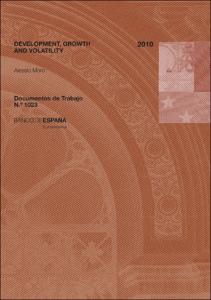Development, growth and volatility
Autor
Fecha de publicación
7-jul-2010
Descripción física
41 p. : gráf.
Resumen
Does GDP composition affect GDP growth and volatility? Typically, economies at advanced stages of development grow slower, are less volatile and have a larger share of services in GDP with respect to economies at middle stages. I propose a theory of development consistent with these three facts. I show that even when total factor productivity (TFP) growth and volatility are the same in manufacturing and services at the gross output level, the larger intensity of intermediate goods in gross output production in manufacturing implies a larger growth and volatility of TFP at the value added level in manufacturing than in services. As GDP is a weighted average of value added of the sectors in the economy, a larger share of services in the economy implies both a smaller GDP growth and a smaller GDP volatility. Numerical results suggest that along a transition path in which the share of services increases from 0.41 to 0.73, the same gross output TFP process in manufacturing and services implies a per-capita GDP growth and volatility 21% and 18% larger in the first part of the transition with respect to the second. These numbers represent 95% of the difference in per-capita GDP growth and 95% of the difference in per-capita GDP volatility between middle and high income economies during the 1970-2006 period. Also, the model can account for 58% of the per-capita GDP growth and 32% of the per-capita GDP volatility differences measured in the U.S. between the 1950-1978 and 1979-2007 periods
Publicado en
Documentos de Trabajo / Banco de España, 1023
Materias
Structural change; Growth; Volatility decline; Total factor productivity; Equilibrio general; Evolución y desarrollo económicos; Fluctuaciones y ciclos económicos; Mercado de trabajo; Estados Unidos; España
Aparece en las colecciones:












